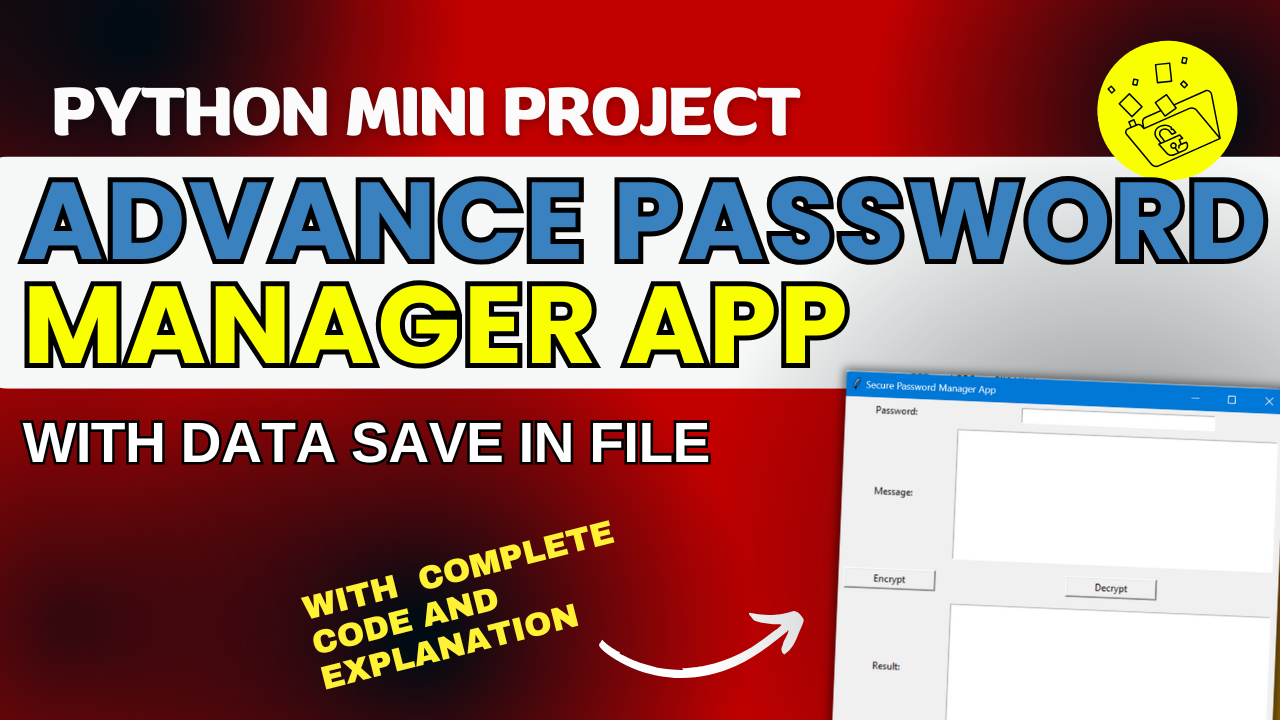Your cart is currently empty!

Password Manager App Using Python
Menu
Password Manager App Using Python
Step 1: Import Necessary Libraries
- Import libraries for cryptographic functions, file handling, and GUI creation:
import hashlib from base64 import b64encode, b64decode import os from Cryptodome.Cipher import AES from Cryptodome.Random import get_random_bytes import json import tkinter as tk from tkinter import filedialog, messagebox
Step 2: Define Encryption Function
- Create a function
encryptto:- Generate a random salt.
- Derive a secure private key from the password and salt using
hashlib.scrypt. - Use the private key with AES in GCM mode to encrypt the input message.
- Return the encrypted data (cipher text, salt, nonce, and tag) in a dictionary.
def encrypt(plain_text, password): if not password: raise ValueError("Password cannot be empty.") salt = get_random_bytes(AES.block_size) private_key = hashlib.scrypt( password.encode(), salt=salt, n=2**14, r=8, p=1, dklen=32 ) cipher_config = AES.new(private_key, AES.MODE_GCM) cipher_text, tag = cipher_config.encrypt_and_digest(bytes(plain_text, "utf-8")) return { "cipher_text": b64encode(cipher_text).decode("utf-8"), "salt": b64encode(salt).decode("utf-8"), "nonce": b64encode(cipher_config.nonce).decode("utf-8"), "tag": b64encode(tag).decode("utf-8"), }
Step 3: Define Decryption Function
- Create a function
decryptto:- Recreate the private key from the password and salt.
- Decrypt the cipher text using AES in GCM mode and verify the integrity using the tag.
- Return the original message.
def decrypt(enc_dict, password): if not password: raise ValueError("Password cannot be empty.") try: salt = b64decode(enc_dict["salt"]) cipher_text = b64decode(enc_dict["cipher_text"]) nonce = b64decode(enc_dict["nonce"]) tag = b64decode(enc_dict["tag"]) private_key = hashlib.scrypt( password.encode(), salt=salt, n=2**14, r=8, p=1, dklen=32 ) cipher = AES.new(private_key, AES.MODE_GCM, nonce=nonce) decrypted = cipher.decrypt_and_verify(cipher_text, tag) return decrypted.decode("utf-8") except (ValueError, KeyError) as e: raise ValueError("Invalid encrypted message format.") from e
Step 4: Add File Save Functionality
- Create
save_to_fileto save encrypted data as a JSON file:def save_to_file(data): file_path = filedialog.asksaveasfilename( defaultextension=".json", filetypes=[("JSON Files", "*.json"), ("All Files", "*.*")], ) if file_path: with open(file_path, "w") as file: json.dump(data, file) messagebox.showinfo("Success", f"Encrypted data saved to {file_path}")
Step 5: Add File Load Functionality
- Create
load_from_fileto load encrypted data from a JSON file:def load_from_file(): file_path = filedialog.askopenfilename( filetypes=[("JSON Files", "*.json"), ("All Files", "*.*")] ) if file_path: with open(file_path, "r") as file: return json.load(file) else: raise FileNotFoundError("No file selected")
Step 6: Create GUI Handlers
1. Encryption Handler
- Handle encryption and:
- Display encrypted data.
- Save it to a file if the user chooses.
- Clear input fields after processing.
def handle_encrypt(): try: password = password_entry.get() plain_text = message_text.get("1.0", tk.END).strip() if not plain_text: raise ValueError("Message cannot be empty.") encrypted = encrypt(plain_text, password) result_text.delete("1.0", tk.END) result_text.insert(tk.END, json.dumps(encrypted, indent=4)) if messagebox.askyesno("Save Encrypted Data", "Do you want to save the encrypted data to a file?"): save_to_file(encrypted) # Clear input fields password_entry.delete(0, tk.END) message_text.delete("1.0", tk.END) except Exception as e: messagebox.showerror("Error", str(e))
2. Decryption Handler
- Handle decryption and:
- Load encrypted data from a file.
- Display the decrypted message.
- Clear input fields after processing.
def handle_decrypt(): try: password = password_entry.get() encrypted = load_from_file() decrypted_message = decrypt(encrypted, password) result_text.delete("1.0", tk.END) result_text.insert(tk.END, decrypted_message) # Clear input fields password_entry.delete(0, tk.END) except Exception as e: messagebox.showerror("Error", str(e))
Step 7: Build the GUI
Create the main window:
root = tk.Tk() root.title("Secure Password Manager App")Add input fields for the password and message:
tk.Label(root, text="Password:").grid(row=0, column=0, padx=10, pady=5) password_entry = tk.Entry(root, show="*", width=40) password_entry.grid(row=0, column=1, padx=10, pady=5) tk.Label(root, text="Message:").grid(row=1, column=0, padx=10, pady=5) message_text = tk.Text(root, height=10, width=50) message_text.grid(row=1, column=1, padx=10, pady=5)Add buttons for encryption and decryption:
encrypt_button = tk.Button(root, text="Encrypt", command=handle_encrypt, width=15) encrypt_button.grid(row=2, column=0, padx=10, pady=10) decrypt_button = tk.Button(root, text="Decrypt", command=handle_decrypt, width=15) decrypt_button.grid(row=2, column=1, padx=10, pady=10)Add an output area to display results:
tk.Label(root, text="Result:").grid(row=3, column=0, padx=10, pady=5) result_text = tk.Text(root, height=10, width=50) result_text.grid(row=3, column=1, padx=10, pady=5)Start the GUI application:
root.mainloop()
Step 8: Run the Program
- Save the complete code in a Python file (e.g.,
aes_gui.py). - Install required libraries (
pip install pycryptodome). - Run the script:
python3 aes_gui.py
Now the GUI-based program provides user-friendly encryption and decryption with field-clearing and file management functionalities!
Post Views: 299
1password bitwarden gmail password manager google password manager my passwords my saved passwords on this device norton password manager app norton password manager extension password manager password manager app apk password manager app download password manager app free password manager app free download password manager chrome password manager google passwords and accounts samsung password manager view saved passwords
Leave a Reply